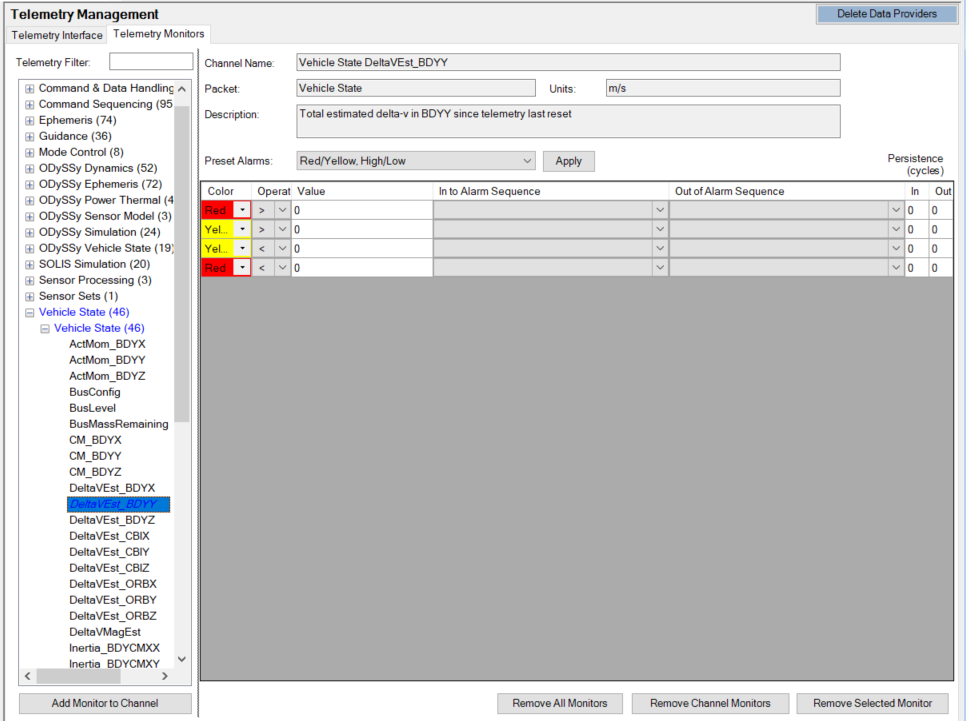Telemetry Monitors
The Telemetry Monitors tab sets up the spacecraft to watch the telemetry values that are being generated by the flight software. You may also set up the telemetry monitors to perform fault protection, which sends EVRs (Event Reports) to the Spacecraft Event Messages page to notify you when telemetry limits have been crossed.
Telemetry monitors are also useful for triggering sequence execution based on In/Out alarms. Event-based triggering can be very useful in designing sequences, as they can be independent of time. This makes your scenario more versatile and not solely valid for one point in time. In addition to Telemetry Monitors, you can also use FlightJAS CHECK statements to design sequences that trigger from events.

Once you select a telemetry channel, there are several presets for alarms that automatically set the color and operator for the selected channel:
| Preset | Description |
|---|---|
| Red/Yellow, High/Low | Adds four instances of the channel with a < and > operator for Red and Yellow. |
| Red/Yellow, High | Adds two instances of the channel with a > operator for Red and Yellow. |
| Red/Yellow, Low | Adds two instances of the channel with a < operator for Red and Yellow. |
| All Levels, High/Low | Adds 10 instances of the channel with a < and > operator for all colors. |
| Check String | Operates on string and enum based telemetry, like an eclipse flag. Adds one instance of the channel with a == operator for Green. |
However, you can also create any kind of monitoring scheme required for your scenario.
Customizing the Telemetry Monitor
To set up an alarm, select a telemetry channel to monitor. You can filter the telemetry tree with the telemetry filter. You can customize each monitor added to the telemetry monitor list for color, operator, value, alarm sequence, and persistence cycles.
Color
There are five color codes indicating five different levels of alarm. In order of least severe to most severe, they are:- Green
- Blue
- Yellow
- Orange
- Red
The color of the most severe alarm used in the scenario as well as the number of monitored telemetry channels shows up on the Spacecraft Status Summary page.
Operator and Value
The paradigm for the operators is that the spacecraft value is on the left side and the user-specified value is on the right side. The available operators include:| Operator | Description |
|---|---|
== | Equal |
< | Less Than |
> | Greater Than |
<= | Less Than or Equal |
>= | Greater Than or Equal |
!= | Not Equal |
abs() == | Absolute Value Equal |
abs() < | Absolute Value Less Than |
abs() > | Absolute Value Greater Than |
abs() <= | Absolute Value Less Than or Equal |
abs() >= | Absolute Value Greater Than or Equal |
abs() != | Absolute Value Not Equal |
abs() operators available when the Value is not a number.Alarm Sequence
Alarm Sequences enable you to define the sequences that get kicked off when the alarm monitor makes the transition either into or out of alarm. The dropdown menu should have a full listing of sequences available in the Sequence Selection page.Persistence Cycles
Persistence Cycles define the number of cycles it takes to have a true reading before it will trigger or come out of an alarm. For example:- An In/Out value of 0 will trigger or end an alarm on the first measured frame that crosses a boundary.
- An In/Out value of 1 will ignore the first frame and trigger on the second frame.
Modifying selected monitor list
- To add a monitor, select it and click
 .
. - To remove an individual item, select it from the channel and click
 .
. - To remove all monitors from the selected telemetry channel, click
 .
. - To remove all monitors from all telemetry channels, click
 .
.